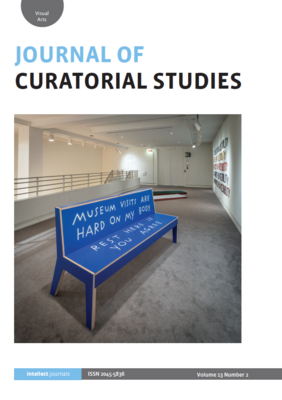
Journal of Curatorial Studies 7.2 is now available
Intellect is thrilled to announce that the beautifully designed Journal of Curatorial Studies 7.2 is now available!
This is a special issue on living display.
For more information about the issue, click here >> https://bit.ly/2C4Qo19
Contents
Living Display
Authors: Jennifer Fisher And Jim Drobnick
Art, Nightlife and the Complexities of Participation: New York’s Area (1983–87)
Authors: Craig Houser
Art and nightlife have intermixed in many cabarets and nightclubs throughout the modern era, and this project focuses on the New York nightclub Area (1983–87). Inspired by surrealism, neo-dada and pop art, Area’s owners acted as artistscurators, as they reinvented their club approximately every five to six weeks by demolishing and rebuilding it based on quirky themes including ‘Suburbia’, ‘Confinement’ and ‘Natural History’. Sculptures, films, photographs, performance art projects, installations and dioramas were featured, and artists included Karen Finley, Keith Haring and Andy Warhol. Such a club questioned issues related to curating living persons and the stereotypical notions of patronage and spectatorship. This social historical analysis, which touches upon gender and queer theory, examines the ethics of participation and how Area exemplified the intermixing of art and nightlife in New York’s nightclubs.
Living Statuary in American Physical Education: Greek Revivalism at Springfield College
Authors: Synthia Sydnor
This article studies living statuary, a Greek revivalism form of tableau vivant that was performed at Springfield College and other physical education programmes from the 1930s. American physical education curated ‘ancient’ Greece through living statuary, yet rarely reflected on the socio-historical context of their preference for ‘antiquity’. The article argues that living statuary serve as normative discourses for the institutions to which they are attached and concludes by suggesting that living statuary rituals be reinvigorated to represent innovative inclusive understandings of ‘fitness’ and ‘beauty’. Cultural interpretive theory and historical-archival methodology ground the research; the work contributes to curatorial studies, physical education history, and reception studies.
Monitoring the Scientist’s Body: The Biosphere 2 Human Exhibition
Authors: Janna Jones And Dana Beasley
This article investigates the ideological and rhetorical consequences of exhibiting the scientist’s body during the 1991–93 Biosphere 2 mission. The facility’s presentation of a technological future was overshadowed by the inability of the Biospherians to thrive within the confines of Biosphere 2, made known to the public via intrusive and unconventional methods of observation. Despite the dome’s popularity, and the previous successes of similarly focused exhibits of science and technology, the inclusion of the Biospherians as part of the exhibition obscured the intended ideology of progress, revealing instead a narrative of the vulnerabilities of humankind. In spite of the rhetorical failure of the 1990s mission, the 2018 Biosphere 2 has recaptured the ideology of scientific progress by removing the scientist’s body from the display and affecting a more publicly accessible research facility, thus allowing for a subsequent rebalancing of traditional power between the scientist and the public.
Museums of the Living Dead: Performance, Body and Memory at Living History Museums
Authors: Stephen Gapps
Since the 1960s, living history museums have become a prominent feature in Australian rural and regional landscapes. Defying their critics, costumed performances at heritage sites continue to attract numerous visitors. This article traces the origins of the living history museum, from its roots in late-nineteenth-century display culture to present-day configurations in the tourist economy. Writing from the perspective of a cultural analyst who has also worked as a costumed interpreter, I consider the range of representations in historical re-enactments, the problems with and possibilities for these sites of performance, and the cultural practices of memory more broadly.
Bones of Contention: Curating the Work of nichola feldman-kiss
Authors: Michelle Gewurtz And Catherine Sinclair
The exhibition nichola feldman-kiss: witness (2015), presented at the Ottawa Art Gallery, included between here and there (2011–15), an installation involving skeletal human remains. This reflection explores the curation of this work as a case study in the premise that exhibitions can be active agents in the construction of knowledge pertaining to polarizing issues of social justice, while balancing the curatorial role as caretaker of objects. It charts the development of the project in relation to the artist’s wider practice, and the curatorial strategy of how, in light of a number of complexities, this sensitive material had to be handled with respect for object, artist and audience.
Exhibition Reviews
Authors: Shauna Jean Doherty And Izabel Galliera And Katarina Veljovic
- VIBRAFUSIONLAB: BRIDGING PRACTICES IN ACCESSIBILITY, ART AND COMMUNICATION Curated by David Bobier, Vtape, Toronto, 13 January – 10 February 2018
- MARX@200 Curated by Kathy M. Newman and Susanne Slavick, SPACE Gallery, Pittsburgh, 6 April – 10 June 2018
- MIKA ROTTENBERG, COSMIC GENERATOR Skulptur Projekte Münster, Germany, 10 June – 1 October 2017
Authors: Cynthia Francica And Chloe Geoghegan
- FEMINISMO Y ARTE LATINOAMERICANO: HISTORIAS DE ARTISTAS QUE EMANCIPARON EL CUERPO, ANDREA GIUNTA Buenos Aires: Siglo XXI Editores Argentina (2018)
- I CAN’T WORK LIKE THIS: A READER ON RECENT BOYCOTTS AND CONTEMPORARY ART, JOANNA WARSZA AND THE PARTICIPANTS OF THE SALZBURG INTERNATIONAL SUMMER ACADEMY OF FINE ARTS (EDS) Berlin: Sternberg Press and Salzburg International Summer Academy of Fine Arts (2017)
Corrigendum: ‘Edging Disciplines’

